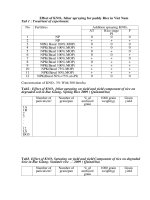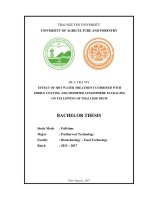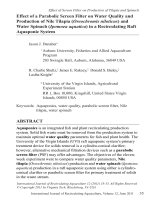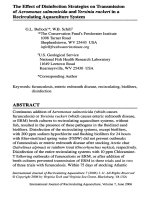Residual effect of fly ash, farm yard manure and fertilizers applied to groundnut on growth parameters, nutrient uptake, yield of sesame and post-harvest soil available fertility
Bạn đang xem bản rút gọn của tài liệu. Xem và tải ngay bản đầy đủ của tài liệu tại đây (180.96 KB, 7 trang )
Int.J.Curr.Microbiol.App.Sci (2017) 6(6): 2917-2923
International Journal of Current Microbiology and Applied Sciences
ISSN: 2319-7706 Volume 6 Number 6 (2017) pp. 2917-2923
Journal homepage:
Original Research Article
/>
Residual Effect of Fly Ash, Farm Yard Manure and Fertilizers Applied to
Groundnut on Growth Parameters, Nutrient Uptake, Yield of Sesame and
Post-Harvest Soil Available Fertility Status in Groundnut - Sesame Cropping
System in Northeastern Zone of Tamil Nadu, India
M. Baskar1, A. Solaimalai2, A. Raj Kumar3* and A. Palanisamy3
1
Department of Social Science, AEC & RI, Kumulur - 621 712, Tamil Nadu, India
Department of Fruit crops, HC & RI, Periyakulam - 625 604, Tamil Nadu, India
3
Agricultural Research Station, Kovilpatti - 682 501, Tamil Nadu, India
2
*Corresponding author
ABSTRACT
Keywords
Grundnut,
Residual effect,
Nutrient uptake,
Cropping system.
Article Info
Accepted:
26 May 2017
Available Online:
10 June 2017
Field experiments were conducted during 2010-12 at Regional Research
Station, Virudhachalam to find out the residual effect of fly ash, farm yard
manure and fertilizers applied to groundnut on growth parameters, nutrient
uptake, yield of sesame and post-harvest soil available nutrients. The
Neyveli Lignite Corporation fly ash contained higher amount of Ca, Mg, S
and Si, moderate amount of P, K and B. Application of fly ash @ 40 t/ha
significantly increased growth parameters, yield attributes, seed yield and
harvest index of sesame. Combination of FYM + STCR based NPK
recorded higher growth characters, yield parameters and seed yield of
sesame crop. Application of fly ash @ 40 t/ha significantly improved
nutrient uptake by residual sesame crop and post-harvest soil available
nutrients in groundnut – sesame cropping system. Maximum nutrient
uptake by sesame and post-harvest soil fertility status were registered under
application of FYM + STCR based NPK.
Introduction
Sesame is one of the important oilseed crops
in India and is called as queen of oilseed
crops due to its excellent quality. The
importance of sesame lies in its high content
of oil, protein, calcium, iron and methionine.
It needs balanced supply of nutrients to
produce higher yield. Fly ash is a waste
product in thermal power stations where
lignite is used to generate electricity.
Dumping up of fly ash will cause air, ground
water and soil pollution besides it is
occupying several lakhs of hectares of
cultivated lands. It can be used as amendment
in crop field. Presence of various nutrients
such as P, K, Ca, S and micronutrients in the
fly ash make it as source of plant nutrients
(Manoharan, 1995). In India, only 3 - 4 % of
the fly ash is utilized as compared to other
2917
Int.J.Curr.Microbiol.App.Sci (2017) 6(6): 2917-2923
countries. Researches on the nutrition of
sesame in the tropics have shown significant
yield increase due to inorganic and
biofertilizers in India (Kalaiselvan et al.,
2002).
Higher number of seeds /plant, capsules
/plant, seed yield/plant, weight of capsule
/plant, test weight, seed yield, straw yield and
harvest index were recorded from 30:60:00 kg
NPK /ha and the combined application of
Azotobacter + PSB (Wayase et al., 2014).
Yield target concept has the added advantage
that targets can be varied by taking into
consideration the resources available. The
targeted yield concept has proved to be
superior to others whose theoretical basis and
proof was demonstrated by Ramamoorthy et
al., (2009).
Targeted yield approach has been an unique
one in the sense that this method not only
indicates soil test based fertilizer dose, but
also the levels of yield, the farmers can hope
to achieve if good agronomy is followed in
raising the crop (Dev and Rattan,1998).
Supply of nutrients through organic manures
[farmyard manure (FYM) and fly ash] to the
first crop in a cropping system and raising
second crop on the residual fertility of those
organic manures along with the application of
chemical fertilizers based on STCR approach
can help to maintain the soil nutrient reserves
for attaining higher crop yields in sequence
cropping system.
Hence, an attempt was made to find out the
effect of fly ash, farm yard manure and
fertilizers applied to groundnut on growth
parameters, nutrient uptake, yield of sesame
and post-harvest soil available nutrients.
Materials and Methods
The field experiments were conducted at
Regional Research Station, Virudhachalam
during 2010 – 12. The experiment was laid
out in split plot design with three replications.
Different levels of fly ash viz., 0, 20 and 40
t/ha was tested in main plots whereas fertilizer
levels such as control (No fertilizer
application), blanket application of NPK,
NPK application based on STCR and FYM @
12.5 t/ha + NPK application based on STCR
were assessed in the subplots.
The soil was sandy loam in texture with PH
6.5 and EC 0.15 dSm-1. The soil available
nutrient contents were low in nitrogen (145
kg/ha), medium in phosphorus (16.2 kg/ha)
and low in potassium (102 kg/ha). Sesame
cultivar VRI1 was sown on 2nd and 7th
October during 2010-11 and 2001-12
respectively.
Fly ash was incorporated into the soil one
week before sowing of groundnut crop as per
the treatments and sesame crop was raised as
residual crop.
No fertilizers and organic manure were
applied for sesame crop. All the
recommended package of practices were
followed during the period of investigation.
Initial and post-harvest soil samples were
collected and analyzed for nutrient
availability.
Plant samples were collected after harvest and
analyzed for nutrient uptake. Growth
parameters such as plant height, leaf area
index and number of branches /plant, yield
attributes such as pods/plant, seeds/pod and
test weight, seed yield and harvest index of
sesame were recorded at harvest stage of
sesame crop.
Results and Discussion
The results obtained from the present
investigation as well as relevant discussion
have been summarized under following
heads:
2918
Int.J.Curr.Microbiol.App.Sci (2017) 6(6): 2917-2923
Properties of fly ash
The Neyveli Lignite Corporation fly ash
contained particles having the size in the
range of 0.002 - 0.2 mm and bringing their
textural class under silty loam. The bulk
density was low (1.08 gcm-3) as compared on
normal cultivable soil. It was also found to be
alkaline in reaction (pH 11.6) and saline (5.2
dSm-1), CEC, organic carbon and total N
contents were 1.60 cmol (p1) /kg, 0.35 % and
0.06 % respectively. The fly ash contained P
(0.07 %), K (0.51 %), Zn (230 mg/kg), Fe
(4200 mg/kg) and B (8.8 mg/kg). It also
consisted of appreciable amount of Si (50.5
mg/kg as SiO2), Ca (14.0 %), Mg (6.4 %) and
S (1.5 %) and very traces of heavy metals (45,
10.6 and 4.5 mg/kg of Cr, Pb and Cd
respectively).
Growth parameters
Fly ash and fertilizer levels exerted a
pronounced effect on plant height, leaf area
index and number of branches/plant (Table 1).
Among the fly ash levels, uses of fly ash @
40 t/ha recorded higher plant height (85.7 and
83.9 cm), leaf area index (2.94 and 2.90) and
number of branches /plant (10.97 and 10.83)
and was on par with application of fly ash @
20 t/ha.
Application of fly ash increased the
availability of nutrients throughout the crop
period, which might be the reason for higher
growth parameters of sesame. Similar results
were also reported by Prakash (2014). With
regard to fertilizer levels, maximum plant
(88.5 and 87.1 cm), leaf area index (3.13 and
3.07) and number of branches/plant (11.42
and 11.33) were observed under application
of FYM + STCR based NPK which was
followed by the application of NPK based on
STCR.
This might be due to balanced and sustained
supply of all the plant nutrients by the
combined application FYM + STCR based
NPK. Similar findings were reported by
Ragupathy (1988).
The lowest growth characters were registered
under control (No fertilizer application)
during both the years.
Nutrient uptake
Application of fly ash and fertilizers to
groundnut crop significantly improved the
nutrient uptake of residual sesame crop during
both the years (Table 2).
Application of fly ash @ 40 t/ha increased the
uptake of N (39.2 and 38.3 kg/ha), P (8.86
and 8.74 kg/ha), K (28.8 and 28.5 kg/ha),
calcium (26.8 and 25.9 kg/ha), Mg (6.29 and
6.14 kg/ha) and sulphur (7.51 and 7.33 kg/ha).
By providing conducive physical environment
and essential nutrients, the addition of fly ash
might have enhanced uptake of nutrients by
the crop.
The lowest nutrient uptake by sesame was
resulted when no fly ash was applied to
groundnut crop. As far as fertilizer levels
concerned, maximum uptake of nutrients
were registered under combined application
of FYM + STCR based NPK which was
followed by the application of NPK based on
STCR value alone.
This might be due to the balanced supply of
plant nutrients both by FYM and chemical
fertilizers and higher growth parameters under
application of FYM + STCR based NPK.
Similar results were earlier reported by
Seshadri Reddy et al., (2005). No fertilizer
(control) recorded the lowest uptake of
nutrients by residual sesame crop.
2919
Int.J.Curr.Microbiol.App.Sci (2017) 6(6): 2917-2923
Table.1 Residual effect of fly ash and fertilizer levels applied to groundnut on
Growth parameters, yield attributes and yield of sesame
Treatments
Growth parameters
Plant
Leaf
Branches
height
area
/ plant
(cm)
index
Yield attributes
Pods /
Seeds/
1000
plant
pod
seed
weight
(g)
2010-11
Fly ash levels
Seed
yield
(kg/ha)
Harvest
index
(%)
0 t/ha
20 t/ha
40 t/ha
CD (5%)
73.2
2.45
7.33
23.41
42.45
2.56
690
22.11
81.1
2.75
9.45
25.94
46.82
2.62
769
23.76
85.7
2.94
10.97
27.39
48.07
2.68
794
23.94
5.8
0.26
1.69
0.68
3.11
NS
30
-
Control
Blanket
NPK
NPK
based on
STCR
FYM
+
NPK
based on
STCR
CD (5%)
61.4
2.02
6.71
19.64
38.92
2.43
442
21.36
78.8
2.88
9.64
25.19
44.28
2.56
708
22.83
82.3
2.96
10.56
26.27
46.41
2.67
766
23.64
88.5
3.13
11.42
28.29
49.96
2.74
822
24.09
6.2
0.29
1.83
0.71
3.26
NS
33
-
Fertilizer levels
2011-12
Fly ash levels
0 t/ha
20 t/ha
40 t/ha
CD (5%)
70.5
2.41
7.24
23.25
41.31
2.52
648
22.03
80.4
83.9
2.68
9.37
25.78
45.66
2.59
733
23.70
2.90
10.83
27.23
46.93
2.65
777
23.88
5.5
0.23
1.63
0.65
3.03
NS
29
59.7
1.94
6.66
Control
Blanket
NPK
NPK
based on
STCR
FYM
+
NPK
based on
STCR
CD (5%)
19.08
37.81
2.41
405
21.30
76.3
2.81
9.52
24.47
43.15
2.52
691
22.78
80.6
2.90
10.47
25.54
45.27
2.63
727
23.56
87.1
3.07
11.42
28.47
48.81
2.71
805
24.02
5.9
0.26
1.80
0.69
3.22
NS
31
-
Fertilizer levels
2920
Int.J.Curr.Microbiol.App.Sci (2017) 6(6): 2917-2923
Table.2 Residual effect of fly ash and fertilizer levels applied to groundnut on
Uptake of nutrients (kg/ha) by sesame crop
Treatment
Nitrogen
2010 2011
Phosphorus
2010 2011
Potassium
2010 2011
Fly ash levels
Calcium
2010 2010
Magnesium Sulphur
2010 2011 2010 2011
0 t/ha
20 t/ha
40 t/ha
CD (5%)
33.86 32.31
37.42 36,57
39.28 38.39
1.9
1.8
6.98
8.34
8.86
0.39
6.86
8.25
8.74
0.36
21.82 21.07
26.53 25.93
28.85 28.58
1.18 1.13
Fertilizer levels
19.14 18.47
24.92 24.14
26.87 25.92
1.08 1.03
4.69
5.77
6.29
0.26
4.51
5.64
6.12
0.24
5.06
6.59
7.51
0.29
4.84
6.41
7.33
0.26
Control
Blanket
NPK
NPK based
on STCR
FYM +
NPK based
on STCR
CD (5%)
23.14 20.48
36.65 35.61
5.02
8.38
4.78
8.17
16.42 15.56 14.81 14.03
23.65 22.93 21.37 20.64
3.26
5.37
3.11
5.22
3.48
5.86
3.31
5.70
40.81 39.29
9.41
9.03
25.68 24.75 22.39 21.77
6.09
5.85
6.69
6.42
46.27 44.63 10.44 10.01 28.21 27.13 25.56 24.94
6.80
6.57
7.72
7.45
1.96
0.22
0.26
0.31
0.29
1.88
0.43
0.41
1.22
1.16
1.12
1.06
Table.3 Residual effect of fly ash and fertilizer levels applied to groundnut on available nutrients
(kg/ha) of soil after harvest of sesame crop
Treatment Nitrogen
Phosphorus Potassium
Calcium
Magnesium Sulphur
2010 2011 2010 2011 2010 2011 2010 2010 2010 2011 2010 2011
Fly ash levels
0 t/ha
20 t/ha
40 t/ha
CD (5%)
147
149
151
5.4
148
150
153
4.9
14.0
15.6
16.5
0.61
13.8
15.9
17.1
0.56
110 108 3.49
115 114 5.39
118 119 6.26
4.3
4.0 0.18
Fertilizer levels
3.46
5.30
6.19
0.15
1.26
2.80
4.14
0.08
1.24
2.91
4.25
0.07
7.0
13.9
19.3
0.51
6.9
14.5
20.6
0.47
Control
Blanket
NPK
NPK
based on
STCR
FYM +
NPK
based on
STCR
CD (5%)
138
144
135
147
11.6
15.0
11.4
15.9
98
112
96
110
5.53
5.48
5.50
5.45
2.58
2.57
2.54
2.53
13.3
13.1
13.1
13.0
151
153
16.2
17.3
116
117
5.50
5.42
2.58
2.55
13.0
12.8
158
161
17.5
18.7
121
123
6.09
5.98
3.19
3.12
14.1
14.3
5.5
5.2
0.66
0.62
4.4
4.2
0.21
0.19
0.11
0.09
0.59
0.55
2921
Int.J.Curr.Microbiol.App.Sci (2017) 6(6): 2917-2923
Yield parameter and yield
Post-harvest soil fertility status
Fly ash and fertilizer applied to groundnut
crop had significant influence on yield
parameters, seed yield and harvest index of
residual sesame crop (Table 1). The 1000
seed weight of sesame was not significantly
influenced by both the fly ash and fertilizer
levels applied to groundnut crop. Higher
number of pod /plant (27.39 and 27.23),
number of seeds/pod (48.07 and 46.93), seed
yield (794 and 777 kg/ha), harvest index
(23.94 and 23.88 %) were registered when fly
ash applied @ 40 t/ha but it was comparable
with that of application of fly ash @ 20 t/ha.
A seed yield increase of 104-128 kg/ha was
observed due to the application of fly ash @
40 t/ha over control. Similar finding was
obtained in black gram by Anandaraj (2009).
The enhanced nutrient availability in the
lateritic soil which are generally characterized
by multinutrient deficiencies, coarse texture
and poor organic carbon and favourable
changes in physical and microbiological
properties might be ascribed for the marked
response in sesame to the addition of fly ash.
These results were corroborated with the
earlier findings of Prakash et al., (2014).
Control registered the lowest yield
parameters, seed yield and harvest index of
sesame crop.
The available nutrients of the post-harvest soil
were found to increase by the addition of
graded levels of fly ash and fertilizer levels
(Table 3). Not only the supply of nutrients,
but also the increase in pH of the soil by fly
ash application might have indirectly helped
to increase the nutrient availability of soil.
The fly ash might not have contributed N
from it directly since it contained only
negligible quantity of N, but it was found to
supply P and K as evidenced by the marked
increase in their content in the post-harvest
soil samples.
Among the fertilizer levels, application of
FYM + NPK as per STCR value produced
significantly higher number of pod /plant
(28.29 and 28.47), number of seeds/pod
(49.96 and 48.81), seed yield (822 and 805
kg/ha) and harvest index (24.09 and 24.02 %).
This might be due to the higher uptake of
plant nutrients and growth parameters of
sesame under FYM + STCR based NPK
application. Similar results were recorded by
Varalakshmi et al., (2005) and Nayak et al.,
(2014). Control (no fertilizer application)
gave the lowest seed yield and harvest index
during both the years.
Khan et al., (1996) reported increase in
available P and K status in soil and they
attributed it to the P and K content of fly ash.
The combined addition of fertilizer and FYM
recorded higher availability of post-harvest
soil nutrients. The synergistic effect of FYM
and fertilizer NPK would have resulted in
higher soil fertility status after harvest of
sesame crop. Similar results were also
reported by Malewar (1996). Control and
treatments with fertilizers alone exhibited a
sharp decline in the availability of secondary
nutrients than combined application of FYM
+ fertilizers.
It can be concluded that application of fly ash
@ 40 t/ha applied to groundnut crop
significantly increased growth parameters,
yield attributes and seed yields of succeeding
sesame crop. FYM @ 12.5 t/ha + STCR based
NPK applied to preceding groundnut crop
recorded higher growth attributes, yield
parameters, yield and nutrient uptake of
succeeding sesame crop.
Application of fly ash @ 40 t/ha significantly
improved nutrient uptake of sesame and postharvest soil available nutrients in groundnut sesame cropping sequence.
2922
Int.J.Curr.Microbiol.App.Sci (2017) 6(6): 2917-2923
References
Anandaraj, P. 2009. Studies on the effect of
fly ash seed pelleting on seed yield and
seed quality in black gram and bhendi.
M.Sc (Agriculture) Thesis, Annamalai
University, Annamalai Nagar.
Dev, G., and Rattan, R. K. 1998. Nutrient
management issues in red and lateritic
soils. In: Managing red and lateritic
soils for Sustainable agriculture,
Volume I, P: 321-337.
Kalaiselvan, P., K. Subramaniyan and
Balasubramaniyan, T. N. 2002. Effect
of application of N and K on the
growth, yield attributes and yields of
sesame.
Sesame
and
Safflower
Newsletter, 17: 62-65.
Khan, S., T. Begum and Singh, J. 1996. Effect
of fly ash on physic-chemical properties
and nutrient status of soil. Indian J.
Environ. Hlth, 38 (1): 41-46.
Malewar, G. V. 1996. Fly ash research at
Marthwada Agricultural University,
Parbhani, P: 2.
Manoharan, V. 1995. Utiliation of lignite fly
ash and crop response in Neyveli Soil.
In: Proc. National Seminar on Use of
lignite fly ash in agriculture, Annamalai
University, Annamalai Nagar, P: 86-88.
Nayak, S. S., K. Brahmachari and
Chowdhury, R. 2014. Integrated
approach in nutrient management of
sesame with special reference to its
yield, quality and nutrient uptake. The
Bioscan, 9 (1): 101-105.
Prakash, M., G. Sathiya Narayanan, B. Sunil
kumar and Rajiv, G. 2014. Effect of fly
ash application on photosynthesis,
growth and yield of sesame. Indian J.
Agric. Res., 48(2): 105-112.
Ramamoorthy, K., S. Radhamani, M.
Mohamed Amanullah and Subbiah, P.
2009. Role of food legumes in organic
farming. Green Farm, 2(12): 830-834.
Regupathy, B. 1988. Effect of lignite fly ash
as sorce of silica and phosphorus on
rice, maize and sugarcane in lateritic
soil. Ph.D Thesis, Faculty of
Agriculture, Annamalai University,
Annamalai Nagar.
Seshadri Reddy, S., B. Shivaraj, V. C. Reddy
and Ananda, M. G. 2005. An efficient
nutrient management system for a
groundnut (Arachis hypogaea)-maize
(Zea mays L.) cropping system in
Karnataka,
India.
Trop.
Agric.
(Trinidad), 82(3): 183-187.
Varalakshmi, L. R., C. A. Srinivasamurthy
and Bhaskar, S. 2005. Effect of
integrated use of organic manures and
inorganic fertilizers on organic carbon,
available N, P and K in sustaining
productivity of groundnut-finger millet
cropping system. J. Indian Soc. Soil
Sci., 53(3): 315-318.
Wayase, K. P., B. D. Thakur and Bhalekar,
M. D. 2014. Influence of chemical
fertilizer and biofertilizer application on
yield contributing characters of sesame.
World J. Agric. Sci., 10(3): 91-94.
How to cite this article:
Baskar, M., A. Solaimalai, A. Raj Kumar and Palanisamy, A. 2017. Residual Effect of Fly Ash,
Farm Yard Manure and Fertilizers Applied to Groundnut on Growth Parameters, Nutrient
Uptake, Yield of Sesame and Post-Harvest Soil Available Fertility Status in Groundnut Sesame Cropping System in Northeastern Zone of Tamil Nadu. Int.J.Curr.Microbiol.App.Sci.
6(6): 2917-2923. doi: />
2923









